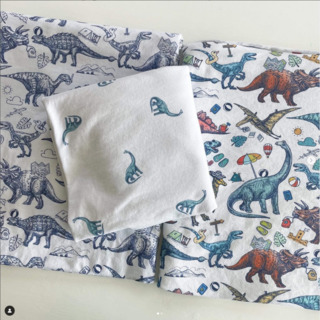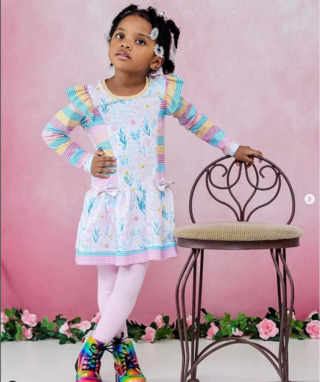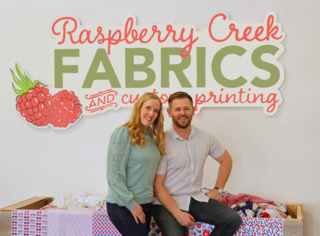Two Steps Forward
Raspberry Creek Fabrics patents a unique process for digital textile printing.

In July 2020, in the heart of the pandemic, we wrote about how Utah-based Raspberry Creek Fabrics implemented automation into its fabric printing process to streamline operations and increase profitability.
Now the company has gone a step further, receiving a patent for a unique web-to-print software for roll-to-roll fabric printing. This automates the step-and-repeat process in a way that creates the smallest possible file, speeding the printing process for a company that prints thousands of step-and-repeat designs on more than 30 different fabric types with orders ranging from a half a yard to more than 100 yards.
Co-Founder Justin Rammell sat down with us to explain the process.
WhatTheyThink: So remind us how you, as an attorney in the oil and gas business, got into fabrics in the first place.
Justin Rammell: My wife, Diana, grew up on a ranch in Wyoming, and she loves to sew her own clothes. She has even sewn her own swimsuits. But when she went to the fabric store looking for fabrics for her projects, she could not find anything that met her needs.
She said, “I want cute prints for my kids and I want to sew.”
And so she started doing some designs; we had them screen printed, and she started selling on Etsy and it kind of took off. That was about 10 years ago. In April of 2017, we bought a Kornit Allegro and started doing our own printing. And then we added an EFI Reggiani NEXT dye sublimation printer for polyesters. We also purchased a Zund cutter.
WTT: That’s a pretty impressive portfolio. When we spoke a couple years ago, you talked about the process you went through to automate your production, and it sounded like that was going pretty well. What issues did you continue to have that drove the solution you have now patented, which was published as U.S .11275532 B1?
JR: Our biggest problem was how time-consuming it was to process files. Looking at the orders at the end of the day, you might see, for example, five yards to print on cotton jersey, three yards of swimwear with sunflowers… basically a hundred orders a day with a half a yard here, three yards there and 30 different fabric types with many different patterns to print. It was a total nightmare We were running two full shifts a day.
WTT: So how did you approach finding a resolution?
JR: We needed to figure out a way to step and repeat files that had already been ripped in order to reduce the processing time. We talked with many of the best-known printer and RIP manufacturers, and they all said they could do this, but they were not able to deliver. All of them wanted to do the imposition of the images up front, but that creates a huge file that takes forever to RIP – like a 200-gigabyte file for 10 yards of a print. It’s just a mess. In many of their installations, that process works since they are printing 200+ yards at a time of the same pattern, but when you have 200 orders a day ranging from half a yard to who knows what, it’s just not feasible.
WTT: So what happened next?
JR: I had an idea for a software patent, and I talked it over with a cousin in the software business out in San Francisco. She discouraged me, saying it was really difficult to get a software patent these days with the Supreme Court tightening the rules. But she did introduce us to a top patent law firm in Washington D.C., and while they couldn’t give us any guarantees, they were willing to try. And they were able to get the patent published on March 15, in about eight months.
WTT: That’s incredible. So tell us what this process does.
JR: So what we do is send one repeat of the pattern through the RIP. After it comes out of the RIP in the smallest possible size, we intercept the file and insert the customer order information as XML code. When the file hits the printer, the printer workstation reads the XML code and knows it needs to step and repeat the file for 50 yards or whatever the amount is. So instead of trying to push a 200 gigabyte 10-yard file through, we are putting a two-megabyte file through, because at that stage, doing the step-and-repeat process doesn’t take any computer resources at all.
WTT: But then how are you managing the orders so you aren’t constantly changing out fabric types?
JR: The beauty of this process is that the printer operator has a dashboard and can see, for example, that they have 1,000 yards to print, and they need to do 100 yards of it in cotton jersey. All of the jobs are pre-ripped and just waiting in the cloud, so they push print for 100 yards of cotton jersey. That’s all they have to do. The jobs come in from the web into hot folders and into the print queue, and they print automatically one after the other.
Another nice feature of the software is that each file prints a header with our logo, the customer name and order number. That’s been a big advantage, because before, the printer would spit out, for example, five yards of a sunflower print, and when it got to fulfillment, they were never quite sure what to do with it. So now, there are two or three wire racks for every day of orders. They are organized by order number and the fulfillment people know exactly where each one goes because each print is labeled.
WTT: In addition to faster print production, the streamlining in fulfillment must make a big cycle time difference as well.
JR: Absolutely. Actually, we had two fulfillment people quit, life changes – one went to college and the other relocated because of her husband’s job. And we didn’t need to hire anyone to replace them. Not only do we now have less staff, we are down from two shifts to one and shipping out a higher volume of orders. We are a husband-and-wife team with about eight employees, and we generate all of our designs ourselves. We need all of the efficiencies we can get.
WTT: Is there anything else this process is enabling for the business?
JR: Yes. We are introducing “Artist Studios” so that any designer can upload images to our website to sell for a royalty. The system is in testing now and will go live in a few weeks. They will have full control over their designs, see the customer order information, track sales, and get paid automatically through PayPal. Their page will have their profile pic and social media information.
WTT: Who did the software development for you?
JR: We hired a couple different outfits to do different aspects of the development. But the core coding was done by Mitko Medev. He didn’t know anything about fabric or ripping, but he is a really smart guy. We paid him as a contractor, but I also put his name on the patent since he was so integral to the success of the process. We wanted to give him that recognition. He assigned the patent to Raspberry Creek, so he is listed, but we are the owners of the patent. Another friend of mine, who is a software developer, looked at the code and remarked how elegant it was. The end result is this web-to-print software where nobody has to touch a file.
WTT: What’s next for Raspberry Creek?
JR: Right now we are printing natural fibers with Kornit systems because of the trouble involved with pre- and post-treatment. We have been experimenting with different inks and processes to treat in-house. I’m not aware of anyone else doing it. The results so far are phenomenal. We are still looking for at different options right now, so if any of your readers have ideas, they could reach out.
We are also going to start doing more cutting. So for example, a customer who's making a hoodie can order the pattern printed in their size with the design they want, and then we can cut it and send them the pieces for sewing. We can place the cutting marks in our files, and we have automation in place that allows us to integrate cutting. Sewists hate to cut, so we think this will be a really popular option.
WTT: Anything else on the horizon?
JR: The nice thing about this automation system we have in place is that it is scalable. So we could put a printer anywhere in the world and be able to plug it into our system to do automated printing. I believe that will help us break into the home textile market. I mean, we are already printing on linen for apparel. We can just as easily print even wall décor and other home textiles.
WTT: Well, congratulations on all of this progress. It’s people like you who are helping rebuild the textiles industry in North America.





